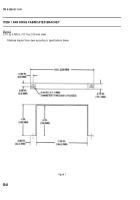TM-9-2350-311-34-1 - Page 318 of 352
NOTE
TM 9-2350-311-34-1
E-3 TIGHTENING METAL FASTENERS
When torquing fastener, select torque wrench with range (Table E-2) that fits required torque value. A torque wrench is
most accurate from 25% to 75% of its stated range. A torque wrench with stated range of 0-100 Ib-ft (0-136 N•m) will
be most accurate from 25-75 Ib-ft (34-102 N•m). Accuracy of readings will decrease as you approach 0 Ib-ft (0 N•m) or
100 Ib-ft (136 N•m). The following ranges (Table E-2) are based on this principle:
TABLE E-2 TORQUE RANGES
STATED RANGE
MOST EFFECTIVE RANGE
0-200 Ib-ft (0-271 N•m)
4-13 Ib-ft (5-18 N•m)
0-600 Ib-ft (0-813 N•m)
50-50 Ib-ft (68-610 N•m)
0-170 Ib-ft (0-230 N•n)
44-131 Ib-ft (60-178 N•m)
15-75 Ib-ft (20-102 N•m)
30-60 Ib-ft (41-81 N•m)
E-4 FASTENER SIZE AND THREAD PATTERN
Threaded fasteners are categorized according to diameter of fastener shank. Thread styles are divided into broad
groups; two most common ranges being coarse (Unified Coarse-UNC) and fine (Unified Fine-UNF). These groups are
defined by the number of threads per in. on the bolt shanks. In addition, threads are categorized by thread class (Table
E-3), which is a measure of the degree of fit between the threads of the bolt or screw (external threads) and the threads
of the attaching nut or tapped hole (internal threads). The most common thread class for bolts and screws is class 2.
TABLE E-3 THREAD CLASSES AND DESCRIPTION
EXTERNAL
I
INTERNAL
I
FIT
1A
1B
Loose fit
2A
2B
Medium fit
3A
3B
Close fit
Thread patterns are designed as follows:
Unless followed with -LH (e.g., 3/4-1 OUNC-2A-LH), threads are right-hand.
E-4
Back to Top




















